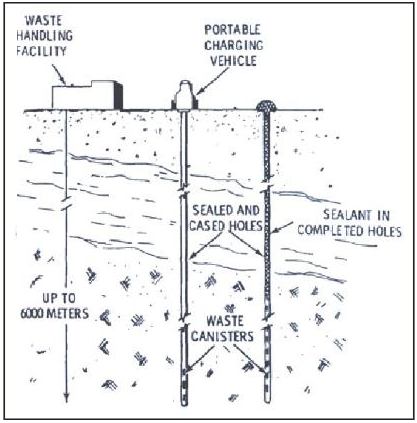(This is Part Two of a two part article. Please read Part One before reading Part Two.)
Deep borehole disposal (DBD) is superior to mined geological repositories (MGR) which are mined about sixteen hundred feet underground.
1) MGRs can cost billions of dollars to prepare before they can take any waste. Deep boreholes will cost in the tens of millions of dollars each and can be drilled one at a time as needed.
2) DBD requires granite formations which are found under much of the continental United States. There are far fewer sites that are suitable for MGRs.
3) It would take about five years to drill a deep borehole, fill it with waste and seal it. In contrast, a prospective MGR in the U.K. will begin construction in 2040 and not take any waste until 2075. A final site for such a repository has not yet been selected. In the U.S., it is estimated that the soonest a MGR could be ready to accept any waste would be 2050.
4) DBD puts the nuclear waste much deeper than MGRs and is much safer. With many potential sites available in the U.S., it should be easier to find a site that will meet with public approval than trying to site a MGR.
5) DBD does not require a big site and has much less environmental impact than MGRs. The diameter of the borehole for DBD would be about two feet. Multiple holes could be drilled at the same site if they are spaced about a hundred feet apart. Once the waste has been placed in the borehole and the hole filled and covered, all infrastructure can be removed. With proper landscaping, the disposal location could be invisible.
6) Seismic activity could possibly crack the containers of waste, fracture the rock around the borehole and damage the deepest barriers. However, such seismic activity would not destroy the isolation of the waste or make it possible for any radioactive materials to make their way to the surface or into the ground water above the waste.
While a great deal of research on DBD has been done in the U.K. at the University of Sheffield and other institutions, it will be tested first in the U.S. A trial hole about half a yard in diameter will be drilled. Tests will be conducted to guarantee that waste packages can be inserted into the borehole and retrieved, if necessary. These tests will be conducted in 2016. If the tests are successful, real Hanford waste capsules will be inserted into boreholes that are about eight inches in diameter for permanent disposal.
Compared to all the other existing and proposed methods for disposing of high-level radioactive waste, DBD appears to be the safest and cheapest alternative. In many cases, deep bore holes could be drilled on site at existing nuclear power plants. Only a few holes should be necessary at each site to dispose of the spent nuclear fuel filling up cooling pools and dry casks. The U.S. should immediately pursue such DBD. Nuclear waste disposal via DBD will be much faster, cheaper, safer and easier than proposed MGRs.







